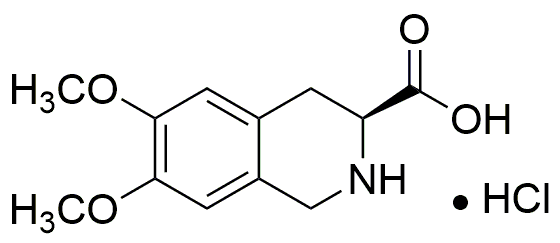(S)-(-)-6,7-Dimethoxy-1,2,3,4-tetrahydroisoquinoline-3-carboxylic acid hydrochloride is widely utilized in research focused on:
- Pharmaceutical Development: This compound is explored for its potential therapeutic effects, particularly in neuropharmacology, where it may aid in the development of treatments for neurological disorders.
- Natural Product Synthesis: It serves as a key intermediate in the synthesis of various natural products, enhancing the efficiency of creating complex molecules in organic chemistry.
- Biochemical Research: Researchers use it to study enzyme interactions and metabolic pathways, providing insights into cellular processes and disease mechanisms.
- Analytical Chemistry: The compound is employed in analytical methods, such as chromatography, to help identify and quantify other substances in complex mixtures.
- Drug Formulation: Its unique properties make it suitable for formulating new drug delivery systems, potentially improving bioavailability and therapeutic efficacy.
Información general
Propiedades
Seguridad y normativas
Aplicaciones
(S)-(-)-6,7-Dimethoxy-1,2,3,4-tetrahydroisoquinoline-3-carboxylic acid hydrochloride is widely utilized in research focused on:
- Pharmaceutical Development: This compound is explored for its potential therapeutic effects, particularly in neuropharmacology, where it may aid in the development of treatments for neurological disorders.
- Natural Product Synthesis: It serves as a key intermediate in the synthesis of various natural products, enhancing the efficiency of creating complex molecules in organic chemistry.
- Biochemical Research: Researchers use it to study enzyme interactions and metabolic pathways, providing insights into cellular processes and disease mechanisms.
- Analytical Chemistry: The compound is employed in analytical methods, such as chromatography, to help identify and quantify other substances in complex mixtures.
- Drug Formulation: Its unique properties make it suitable for formulating new drug delivery systems, potentially improving bioavailability and therapeutic efficacy.
Documentos
Hojas de datos de seguridad (HDS)
La SDS proporciona información de seguridad completa sobre la manipulación, el almacenamiento y la eliminación del producto.
Especificación del producto (PS)
La PS proporciona un desglose completo de las propiedades del producto, incluida la composición química, el estado físico, la pureza y los requisitos de almacenamiento. También detalla los rangos de calidad aceptables y las aplicaciones previstas del producto.
Certificados de análisis (COA)
Busque certificados de análisis (COA) ingresando el número de lote del producto. Los números de lote y de partida se pueden encontrar en la etiqueta de un producto después de las palabras "Lote" o "Lote".
Número de catálogo
Número de lote/lote
Certificados de origen (COO)
Este certificado de origen confirma el país en el que se fabricó el producto y también detalla los materiales y componentes utilizados en él y si se deriva de fuentes naturales, sintéticas u otras fuentes específicas. Este certificado puede ser necesario para cumplir con las normativas aduaneras, comerciales y regulatorias.
Número de catálogo
Número de lote/lote
Hojas de datos de seguridad (HDS)
La SDS proporciona información de seguridad completa sobre la manipulación, el almacenamiento y la eliminación del producto.
DownloadEspecificación del producto (PS)
La PS proporciona un desglose completo de las propiedades del producto, incluida la composición química, el estado físico, la pureza y los requisitos de almacenamiento. También detalla los rangos de calidad aceptables y las aplicaciones previstas del producto.
DownloadCertificados de análisis (COA)
Busque certificados de análisis (COA) ingresando el número de lote del producto. Los números de lote y de partida se pueden encontrar en la etiqueta de un producto después de las palabras "Lote" o "Lote".
Número de catálogo
Número de lote/lote
Certificados de origen (COO)
Este certificado de origen confirma el país en el que se fabricó el producto y también detalla los materiales y componentes utilizados en él y si se deriva de fuentes naturales, sintéticas u otras fuentes específicas. Este certificado puede ser necesario para cumplir con las normativas aduaneras, comerciales y regulatorias.

